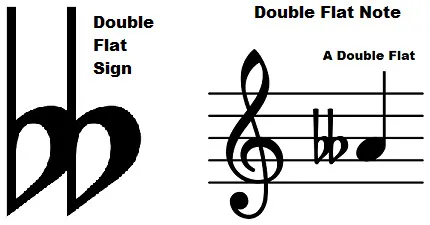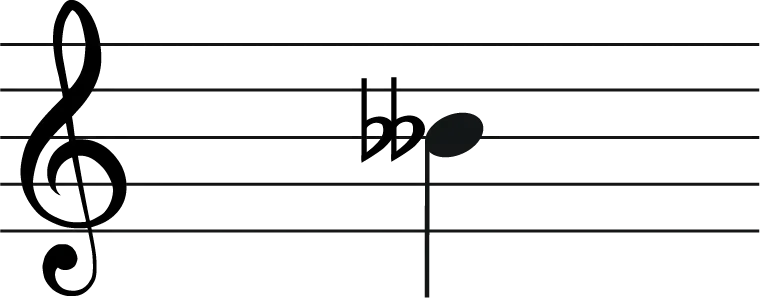Understanding musical notation is essential for anyone who wants to read, perform, or compose music. Among the many symbols used in sheet music, accidentals—like sharps, flats, and naturals—can sometimes be confusing, especially when they involve less common signs like the double flat. The double flat is an important concept in music theory that appears in a variety of contexts, particularly in classical and jazz music. While it may seem complex at first, learning how to read and interpret the double flat can significantly deepen your understanding of musical structure and harmony. In this article, we will explore what the double flat is, how it is written and used in musical notation, its function in theory, and tips for recognizing and working with it effectively. Whether you’re a beginner or a more advanced musician, mastering the double flat will help you become more fluent in the language of music.
What Is a Double Flat?
A double flat, notated as 𝄫, is a musical symbol that lowers the pitch of a note by two half steps, or one whole step. To put it simply, if a flat (♭) lowers a note by one semitone, a double flat lowers it by two. For example, if you take the note B and apply a flat, you get B♭. If you apply another flat to that note (making it a double flat), it becomes B𝄫—which sounds the same as the note A.

The concept is straightforward in theory but may appear confusing when seen in actual sheet music. A key thing to remember is that the double flat does not introduce a new pitch, but rather re-labels an existing pitch in a different theoretical context. This distinction is essential in harmonic analysis, particularly in classical compositions where voice-leading and proper notation etiquette require such specificity.
The double flat is an accidental, which means it temporarily alters the pitch of a note outside of the key signature. It is only valid for the measure in which it appears unless a tie or notation rule extends its effect.
>>View more: List 99+ Music Symbols and Their Functions
Visual Representation
The symbol for a double flat looks like two lowercase flat signs (♭♭), but in modern engraving and printed scores, it is often represented as a unique symbol: 𝄫. This makes it visually distinct from writing two flats side by side. This differentiation is helpful in reducing confusion for musicians, especially during quick sight-reading.
Let’s look at how a double flat is notated on the staff. Suppose you see a B note on the middle line of the treble clef. A flat sign next to it (B♭) would place the pitch a half-step lower. If you see a double flat sign (B𝄫), that same note must be played a whole step lower. In terms of piano keys, instead of playing the black key just before B (which is B♭), you would play the white key A.

For further clarity, composers often use double flats in conjunction with a natural sign to cancel them in the next measure. For example, a sequence may include B𝄫 followed by a B♮, helping the performer distinguish shifts in pitch more clearly.
How Double Flats Work in Practice
Although they might not appear frequently in beginner-level music, double flats serve a critical function in more complex music. They often appear in harmonic or melodic contexts where accurate notation is important for preserving theoretical clarity. For instance, in the key of G♭ minor, the sixth scale degree is E𝄫 instead of D, even though both sound the same. The reason lies in maintaining the correct interval structure and spelling within the scale.
Double flats are also common in diminished chords, chromatic passages, and modulations. Let’s take an example from a jazz or classical harmony setting. A C diminished chord contains the notes C, E♭, and G♭. If we need to write the diminished seventh (B𝄫), it appears as a double flat, even though it’s enharmonically equivalent to an A. Writing it as B𝄫 ensures that the interval from C to B𝄫 is correctly notated as a diminished seventh.
From a performance standpoint, playing a double flat is no different than playing its enharmonic equivalent. But understanding the theoretical role of the double flat can help performers and composers maintain harmonic clarity.
Enharmonic Equivalents
One of the most important concepts to grasp when studying double flats is that of enharmonic equivalents. An enharmonic equivalent refers to two different note names that produce the same pitch. For example, B𝄫 and A sound identical when played, but are notated differently depending on the harmonic or melodic context.
Why would a composer choose to write B𝄫 instead of A? The answer lies in the structure of scales and chords. In tonal music, each scale degree must be represented by a unique letter name. In the case of a G♭ minor scale, writing A instead of B𝄫 would disrupt the expected sequence of letter names in the scale (G♭, A♭, B𝄫, C♭, D♭, E𝄫, F).
Enharmonic equivalents also preserve voice-leading integrity. In four-part harmony, spelling chords accurately allows musicians to see how each voice moves. Even if the pitch remains the same, using the correct note name ensures that the harmonic function is preserved, which is especially important for analysis and transcription.
So, while B𝄫 and A may be the same key on the piano, their meaning and role in the music can be quite different.
Common Contexts and Challenges
Double flats typically appear in complex key signatures, chromatic passages, or pieces with modulation and altered chords. They’re more common in genres like classical, jazz, and progressive rock, and are less likely to appear in beginner-level popular music. Students encountering them for the first time might find them confusing due to their rarity and unusual spelling.
One common challenge is sight-reading music that includes double flats. When reading quickly, it’s easy to misinterpret B𝄫 as B♭ or even B♮. That’s why context matters: being familiar with the key signature and understanding the harmonic structure can help prevent mistakes.
Double flats also appear in augmented sixth chords and other chromatic harmonies. For example, the German augmented sixth chord in the key of C minor may include an A♭ and a B𝄫, even though they resolve to G.
To manage this complexity, it’s important to practice reading music in flat-heavy keys, such as C♭ major or F♭ major. These keys naturally lead to situations where double flats are theoretically correct, even if enharmonic equivalents might seem simpler.
Double Flats and Key Signatures
It’s very rare for double flats to appear in key signatures themselves. Traditional Western music theory does not include any key signatures that require a double flat. Instead, double flats are written as accidentals, placed directly before a note within a measure to alter its pitch.
However, double flats can frequently appear in keys that already have many flats in their signatures, such as C♭ major or G♭ minor. In such cases, using double flats allows composers to maintain the correct interval structure and voice-leading conventions of the key, rather than introducing enharmonic confusion by spelling the note differently.
Double flats also interact with key signatures through accidental rules. For example, if a note has a flat in the key signature and you add a flat in the measure, it becomes a double flat. Also, once a double flat is used in a measure, it stays in effect until the measure ends or until it is canceled by a natural or different accidental.
Being aware of how accidentals interact with key signatures is crucial for playing and interpreting music accurately.
Tips for Learners
If you’re new to double flats, here are a few tips to help you master them:
- Think in terms of steps: A double flat lowers a note by two half steps. Mentally “walk down” the keyboard or fretboard to find the correct pitch.
- Use enharmonic shortcuts: Recognize that B𝄫 is the same as A. This can help with ear training and pitch identification.
- Practice in flat keys: Try playing scales or pieces in keys like G♭ major or C♭ major to become more comfortable with complex accidentals.
- Label and analyze: When studying scores, write in enharmonic equivalents or interval labels to help you understand the function of the double flat in context.
- Repetition helps: Include double-flat examples in your sight-reading practice. Flashcards or music theory apps can be helpful for drilling accidentals visually.
Most importantly, don’t avoid double flats just because they seem complicated. Embrace them as part of the rich language of music.
The double flat symbol may seem intimidating at first, but it plays an important role in music theory, particularly in preserving accurate harmonic spelling and voice-leading. Whether you’re a student deciphering a new piece or a composer writing nuanced harmonies, understanding how and why to use double flats will deepen your fluency in music notation. Remember that even though a B𝄫 might sound like an A, the meaning behind the notation is what truly matters. With practice and thoughtful study, the double flat becomes not just understandable—but intuitive.

Evan Carter is an American music educator. With a background in Musicology and over 10 years of experience, he specializes in music theory and notation. Evan creates clear, accessible content to help learners of all levels understand the language of music through symbols, structure, and sound.

